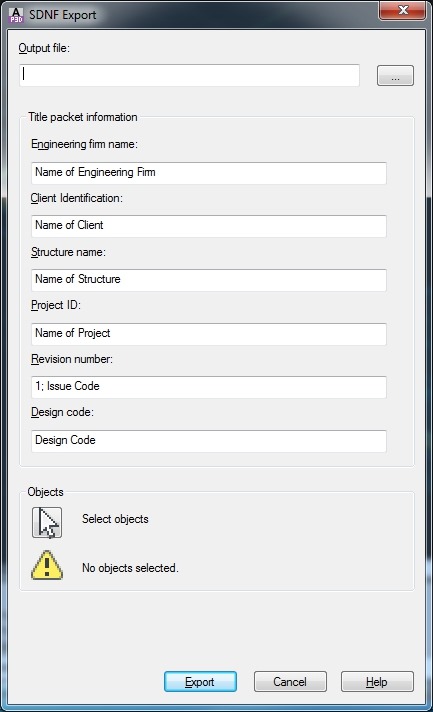• On the File menu, click Import >CAD. The Import Models dialog box opens. • Select Import CAD from the Type list. • Use the default name import model or enter a new name.

Apr 1, 2016 - Bentley. LandXML files (.xml ). Bentley Structural. Direct Link (ISM). Autodesk (.dwg ). Autodesk (.dxf ). CIS/2 LPM6 design (.stp,.p21,.step ). IFC2X3 (.ifc ). Microstation (.dgn ). Steel Detailing Neutral Format (.sdf,.sdnf ). STEP AP203/AP214 (.stp,.step ). Direct Link (ISM). Autodesk (.dwg ). Steel Detailing Neutral Format (.sdf.sdnf,.dat) X. Compatible formats. Tekla software solutions for advanced building information modeling and structural.
Apr 24, 2017 - SDNF(Structural steel Detailing Neutral File) format was originally defined by the Intergraph FrameWorks user community for the transfer of steel data. The format is in the public domain and is therefore available to be considered as a suitable means of transferring data between 3D steel detailing packages. How to link the file with an installed software? If you want to associate a file with a new program (e.g. My-file.SDNF) you have two ways to do it.
• Select the model from the list. • Click Properties to open a dialog box where you can define the settings for the import file: • You can load the standard parameters for PDS and PDMS SDNF files with the Load option. • On the Conversion tab, enter the conversion file names or browse for the conversion files. • On the Parameters tab, enter the name of the SDNF file you want to import in the Input file box, or use the default name. SDNF files normally have a *.dat extension. The version number for SDNF 3.0 files can be found in the header if you open the file with a text editor. • On the Parameters tab, set the file Type to SDNF, and set the origin coordinates in the Origin boxes if you want the file in a specific location.
• Set the SDNF options on the SDNF page: • In the Part Pos_No area enter a prefix and a start position number identifier that is assigned to all similar parts, assemblies, cast units, or reinforcement Position number consists of a prefix, separator, and running number. The prefix is part of the position number, identifying a numbering series.
The running number is part of the position number, and is the assigned number in the numbering series, based on the start number. The separator is an optional character, such as a slash, that separates the prefix and the running number. In Tekla Structures, the position numbers assigned in the numbering are shown in marks and templates, for example.
In the US, the term piece mark or ship mark is used to refer to a position number.. This relates to the Position number type setting. • In SDNF version number, select the SDNF format type ( 2.0 or 3.0 ). SDNF 3.0 is generally the format to select. However, with StruCAD it is better to share SDNF 2.0 files.
• Set Apply cuts and fittings to Yes (default) to apply cuts and fittings in the import. These will only be included if contained within the SDNF file. • Set Consider offsets to Yes to create offsets. In most cases you should select Yes. No (default) positions part creation points at part end points. • You can create a log file.
If the import fails, examine the log file to find out why. Check the log file even if the import seems to have succeeded. In the Create log file, you can select Create to write a new log file, and delete the previous log file, each time you import the model. If you select Append (default), the log file information is added at the end of the existing log file.
• You can also select how the log file is displayed, the options being With an external viewer (like Microsoft Notepad), Not viewed, and In a dialog box, which creates a separate list dialog box in which the file can only be viewed. • Enter the log file name or browse for an existing log file. • The SDNF file contains identifiers that can be included in a part’s user-defined attributes, or used as position numbers. In Position number type, select Part position if you want the identifier to become the part’s position number. Do not use the Part Pos_No fields with this option.
Select Universal ID if you want the identifier to become a user-defined attribute object property created by the user in order to widen the range of predefined object properties User-defined attributes are used when the predefined object properties are not sufficient but more properties are needed. For example, comment, locked, and erection status are user-defined attributes. For the part. In most cases, you would select Universal ID. Bhrigu Samhita Astrology Software on this page. To make user-defined attributes visible, you need to add them to the objects.inp file. For file imports from PDS or PDMS then the Universal ID option is the normal case • If you wish to create a report of the import, enter the required information on the Report tab.